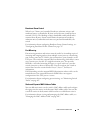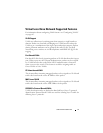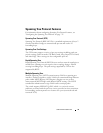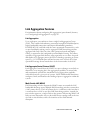
Switch Feature Overview 79
Spanning Tree Protocol Features
For information about configuring Spanning Tree Protocol features, see
"Configuring the Spanning Tree Protocol" on page 715.
Spanning Tree Protocol (STP)
Spanning Tree Protocol (IEEE 802.1D) is a standard requirement of Layer 2
switches that allows bridges to automatically prevent and resolve L2
forwarding loops.
Spanning Tree Port Settings
The STP feature supports a variety of per-port settings including path cost,
priority settings, Port Fast mode, STP Root Guard, Loop Guard, TCN Guard,
and Auto Edge. These settings are also configurable per-LAG.
Rapid Spanning Tree
Rapid Spanning Tree Protocol (RSTP) detects and uses network topologies to
enable faster spanning tree convergence after a topology change, without
creating forwarding loops. The port settings supported by STP are also
supported by RSTP.
Multiple Spanning Tree
Multiple Spanning Tree (MSTP) operation maps VLANs to spanning tree
instances. Packets assigned to various VLANs are transmitted along different
paths within MSTP Regions (MST Regions). Regions are one or more
interconnected MSTP bridges with identical MSTP settings. The MSTP
standard lets administrators assign VLAN traffic to unique paths.
The switch supports IEEE 802.1Q-2005, which is a version of corrects
problems associated with the previous version, provides for faster transition-
to-forwarding, and incorporates new features for a port (restricted role and
restricted TCN).


















